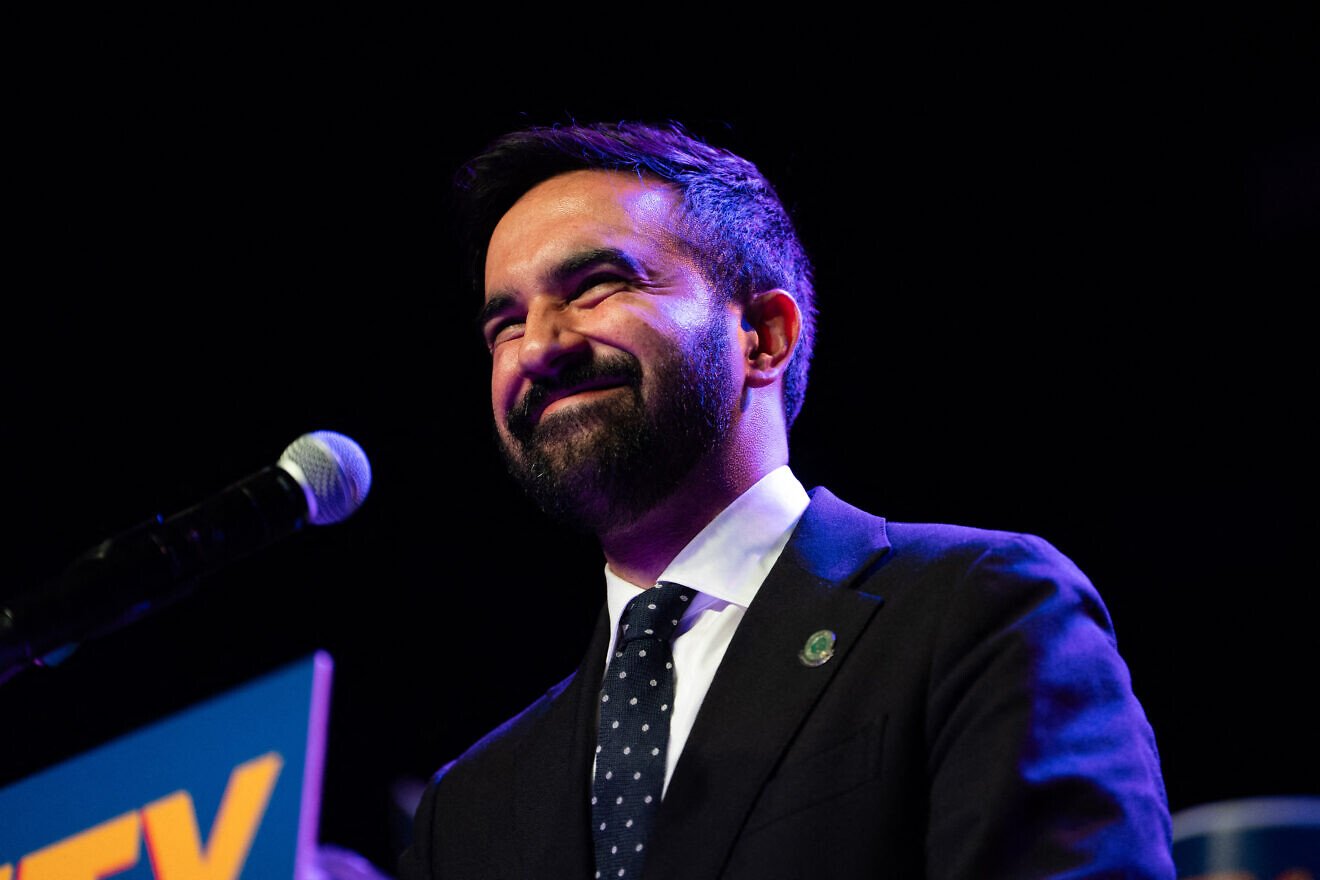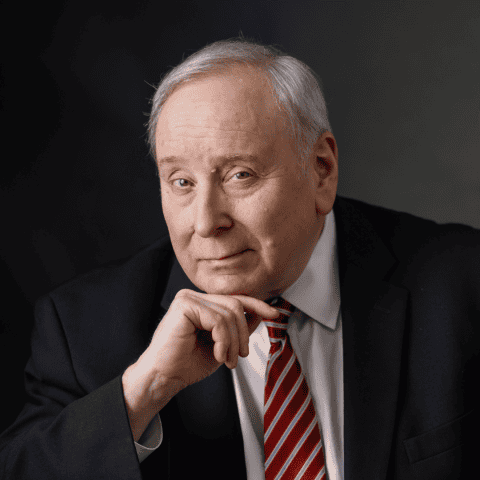Jonathan S. Tobin
The radical candidate’s primary victory means more about what lies ahead for the party than it does about prospects for the survival of American Jews.
 Zohran Mamdani speaks during his first major mayoral campaign rally at Brooklyn Steel in Brooklyn, N.Y., on May 2 2025. Photo by Madison Swart/Hans Lucas/AFP via Getty Images.
Zohran Mamdani speaks during his first major mayoral campaign rally at Brooklyn Steel in Brooklyn, N.Y., on May 2 2025. Photo by Madison Swart/Hans Lucas/AFP via Getty Images.
It was no small irony that I learned the news that Zohran Mamdani would be the Democratic candidate for mayor of New York City and the odds-on favorite to win the general election while I was in Medora, N.D., some 1,755 miles from the city of my birth.
I was born in Manhattan, grew up in the New York City area, went to college at Columbia University, and spent much of my early life in and around the city. Though it’s been many years since I resided there, I have always thought of myself as a New Yorker, regularly attending cultural events in the city and rooting for its sports teams. Rural, oil-drilling, country-music-loving North Dakota is about as far from New York in terms of culture and politics as you can get while remaining in the continental United States.
But as many American Jews were panicking about the victory of Mamdani, a far-left Socialist who sides with those who seek Israel’s destruction, being in North Dakota on a trip with members of the Council for a Secure America to learn more about the intersection of interests between supporters of Israel and those who work in the domestic energy industry turned out to be a piece of unexpected good timing. I found myself surrounded by non-Jews who are ardent supporters of the Jewish state and simply appalled by the surge in antisemitism in this country, of which events in New York City are just the latest evidence.
Tempering despair
That was both a comfort on a day when a lot of New York Jews are talking about leaving a Big Apple, as well as a reminder that the current despair about the future of American Jewry should be tempered by remembering some basic truths about the overwhelming majority of our fellow citizens who do not practice the same faith.
North Dakota is among the least ethnically diverse and one of the whitest states in the union (82.9%), as well as the reddest. President Donald Trump won the state with 67% of its votes, with only West Virginia and Wyoming giving him more support. As such, it is no more representative of the United States as a whole than deep-blue, ethnically and racially diverse New York City, where those who call themselves white make up only 31% of the population.
The truth to keep in mind this week as the country reels from the news that someone like Mamdani may well be the chief executive of its largest and most Jewish city is that North Dakotans are far closer to the national norm in terms of their attitudes toward Israel and antisemitism than the 43.5% of New Yorkers who voted for him.
Polls have shown that the vast majority of Americans have continued to oppose the hatred of Jews and attacks on them, even after the surge was set off by the Hamas-led Palestinian Arab terror attacks on southern Israeli communities on Oct. 7, 2023. And though the tsunami of anti-Israel and antisemitic propaganda about the war on Hamas and its Iranian sponsors has resulted in a decline in support for Israel, a strong plurality of Americans still back the small, beleaguered nation.
The real divide is along party lines, with Republicans—and to a lesser extent, independents—backing Israel by huge majorities. Among Democrats, support for Israel has become a minority opinion.
And that is why it is important to understand the Mamdani win as revealing more about the future of the Democratic Party, both in terms of its attitudes toward Jews and Israel, as well as a sharp turn to the left on other issues than it does about America as a whole.
As I wrote in April, in the aftermath of their 2024 defeat at the hands of Trump and the GOP, all of the enthusiasm and energy among Democrats has increasingly shifted to the hard-left intersectional wing of the party. There are still many moderate Democrats who are heavily represented among its officeholders. Among them are those like Pennsylvania Gov. Josh Shapiro (who is Jewish), who credibly aspires to the 2028 presidential nomination. And it has a few stalwart and vocal supporters of Israel, such as Sen. John Fetterman, also in Pennsylvania, and Rep. Ritchie Torres in New York.
A left-wing Democratic base
But the party’s base belongs to the hard left, especially among the younger generation of voters and politicians. It is to people like Rep. Alexandra Ocasio-Cortez (D-N.Y.), the leader of the progressive “Squad” in the U.S House of Representatives, who many Democrats are now looking for leadership. The faction of the party that was led by Sen. Bernie Sanders (I-Vt.) was bested by the party’s establishment in 2016 and 2020 when it nominated Hillary Clinton and former President Joe Biden. And it never had a chance in 2024 when the fix was in for the visibly declining incumbent, who was replaced in an undemocratic coup by Vice President Kamala Harris of California.
Mamdani’s win in New York is another sign that the party’s base belongs to those who are deeply influenced by toxic left-wing ideologies like critical race theory, intersectionality and settler-colonialism, all of which falsely label Jews and Israel as “white” oppressors. Mamdani, a Muslim who is, like AOC, a Democratic Socialist, is a former college chapter president of the anti-Israel, antisemitic Students for Justice in Palestine; a supporter of the antisemitic BDS movement; opposes the existence of Israel as a Jewish state; wants to “free Palestine” from the Jews; and won’t even admit that the phrase “globalize the intifada” is, like the ubiquitous chants of “from the river to the sea,” a call for terrorism and genocide of the Jews. Like AOC, he also subscribes to a catalog of far-left ideas about the economy and environmentalism that seek to destroy the canon of Western civilization, which would also ruin the country.
There are specific circumstances that enabled his win. The demography of New York City has shifted in the time since a Republican like Rudy Giuliani or even a moderate liberal like Michael Bloomberg won the mayoralty. A critical mass of white ethnic or working-class moderate voters has left the city and gone elsewhere for better opportunities, lower taxes, and less congestion and crime.
Incumbent Mayor Eric Adams left the Democratic Party to run as an independent after the Trump administration ended his prosecution on federal corruption charges. The fact that his most credible moderate primary opponent—former New York Gov. Andrew Cuomo, who was compromised by multiple incidents involving sexual harassment and calamitous decisions that led to the deaths of thousands during the COVID pandemic—came into the race with so much baggage may have made his victory in a multi-candidate race inevitable.
If Mamdani is to be defeated in November, Adams, Cuomo (who can run on an independent line) and Republican candidate Curtis Sliwa will have to unite, with two of them withdrawing in favor of a single candidate. Since that is highly unlikely, New York is likely to find itself governed by someone who is not merely a hard left radical, but a supporter of antisemitic and anti-Israel causes.
Redefining Jew-hatred
This will also give a boost to those on the left, including New York Times columnists Peter Beinart and M. Gessen, who seek to redefine the term “antisemitism” to allow open Jew-haters to claim that they are innocent of the charge. That this kind of gaslighting is regularly platformed in the Times—the publication that is the flagship of American liberalism as well as the most influential newspaper in New York—remains deeply concerning.
While no one thinks an election in New York City is a bellwether for American politics generally, it will put more wind in the sails of Sanders, AOC and others on the hard left who appear to be the future of the Democratic Party. Democrats seem to be prioritizing their obsessive hatred of Trump over a willingness to consider policies and candidates that might win back the sensible middle of American politics, in addition to working-class voters who have abandoned them and think of the president as their champion.
Party leaders fail
Democratic Party leaders like Majority Leader Chuck Schumer (D-N.Y.), who pretends to be the shomer or “guardian” of Israel and the Jews but is more worried about running afoul of the radical left, have made it clear that they are not going to stand up against AOC and Mamdani. Though they don’t share their beliefs, officeholders in both major parties always follow the lead of the base.
That is a shocking and disappointing development for an American Jewish community that is already reeling from an enormous increase in antisemitism that has gone mainstream in legacy media, academia, the arts and popular culture. Some younger Jews, indoctrinated by the radical left throughout their years in school, have embraced people like Mamdani and tend to rationalize his anti-Zionistic and antisemitic rhetoric. That leaves most liberal Jews, who still make up a large majority of the community, without a political home.
This means the battle against antisemitism is now largely being waged by the political right and, in particular, by Trump, who is pro-Israel and waging a much-needed war on academic institutions that have normalized antisemitism and the war on the West.
Jews are not alone
That’s a difficult truth for liberal Jews who hate the president. But it is a reminder that most Americans, whether politically moderate or residents of deep red states like North Dakota, observe the mainstreaming of antisemitism in New York with horror, and oppose people like Mamdani and other radical Democrats. And the more that the Democratic base swings to the left, the more likely it is that their party is going to continue losing national elections.
The shift among Democrats is good news for the GOP but bad news for the Jewish community. It’s also bad for the country as a whole to have one of its two major parties fall into the hands of radicals. And it represents a sea change for Jews in New York, who are now realizing that they may be better off moving to a red state like Florida. As worrisome as this is, it is also a moment for Jews to realize that they are not alone. Hard as it may be to accept that they are now under siege in institutions and cities where they once felt most at home, most Americans outside the nation’s metropolis stand by them.
 Jonathan S. Tobin is editor-in-chief of the Jewish News Syndicate, a senior contributor for The Federalist, a columnist for Newsweek and a contributor to many other publications. He covers the American political scene, foreign policy, the U.S.-Israel relationship, Middle East diplomacy, the Jewish world and the arts. He hosts the JNS “Think Twice” podcast, both the weekly video program and the “Jonathan Tobin Daily” program, which are available on all major audio platforms and YouTube. Previously, he was executive editor, then senior online editor and chief political blogger, for Commentary magazine. Before that, he was editor-in-chief of The Jewish Exponent in Philadelphia and editor of the Connecticut Jewish Ledger. He has won more than 60 awards for commentary, art criticism and other writing. He appears regularly on television, commenting on politics and foreign policy. Born in New York City, he studied history at Columbia University.
Jonathan S. Tobin is editor-in-chief of the Jewish News Syndicate, a senior contributor for The Federalist, a columnist for Newsweek and a contributor to many other publications. He covers the American political scene, foreign policy, the U.S.-Israel relationship, Middle East diplomacy, the Jewish world and the arts. He hosts the JNS “Think Twice” podcast, both the weekly video program and the “Jonathan Tobin Daily” program, which are available on all major audio platforms and YouTube. Previously, he was executive editor, then senior online editor and chief political blogger, for Commentary magazine. Before that, he was editor-in-chief of The Jewish Exponent in Philadelphia and editor of the Connecticut Jewish Ledger. He has won more than 60 awards for commentary, art criticism and other writing. He appears regularly on television, commenting on politics and foreign policy. Born in New York City, he studied history at Columbia University.
 Ofiary izraelskiego ataku w Deir al-Balah w drodze do szpitala Al-Aksa Martyrs w centralnej części Strefy Gazy, 26 czerwca 2025 r. (Fot. REUTERS/Ramadan Abed)
Ofiary izraelskiego ataku w Deir al-Balah w drodze do szpitala Al-Aksa Martyrs w centralnej części Strefy Gazy, 26 czerwca 2025 r. (Fot. REUTERS/Ramadan Abed) “Israel Hajom”: Netanjahu zgodził się zakończyć wojnę w Strefie Gazy w ciągu dwóch tygodni
“Israel Hajom”: Netanjahu zgodził się zakończyć wojnę w Strefie Gazy w ciągu dwóch tygodni Premier Izraela Benjamin Netanjahu Fot. REUTERS/Jack Guez
Premier Izraela Benjamin Netanjahu Fot. REUTERS/Jack Guez




